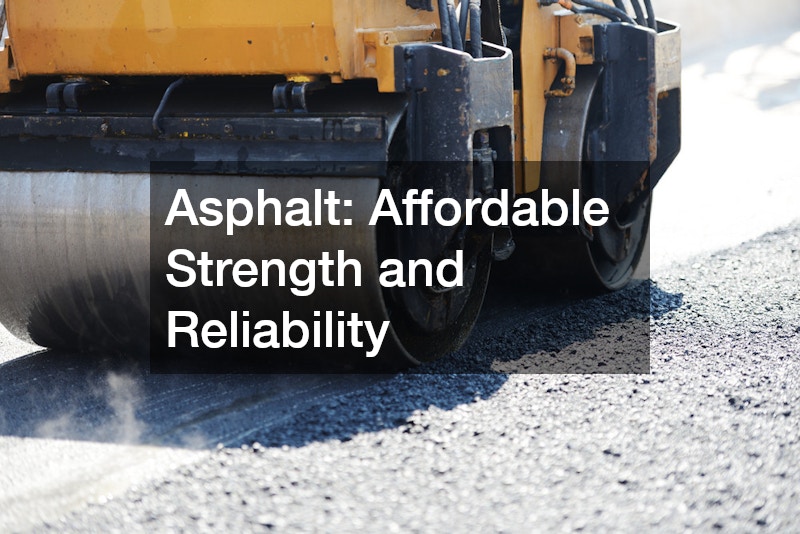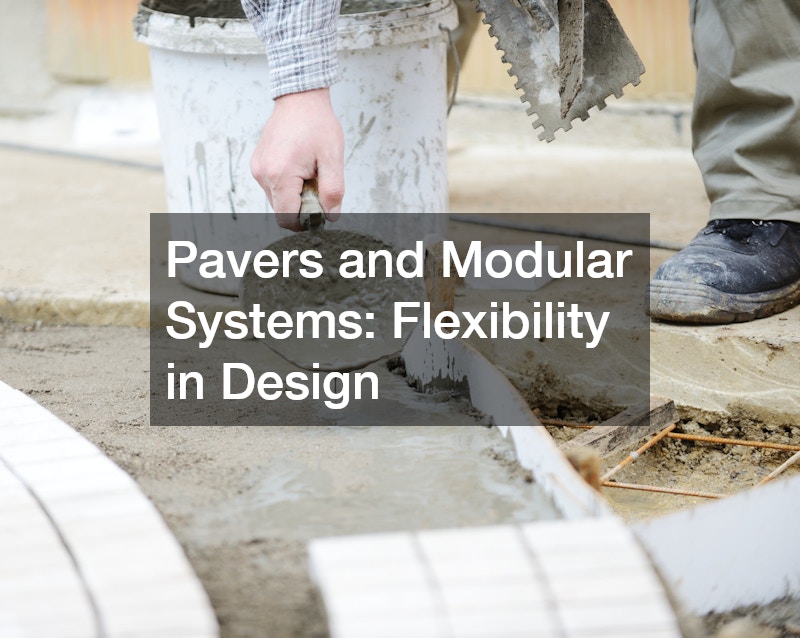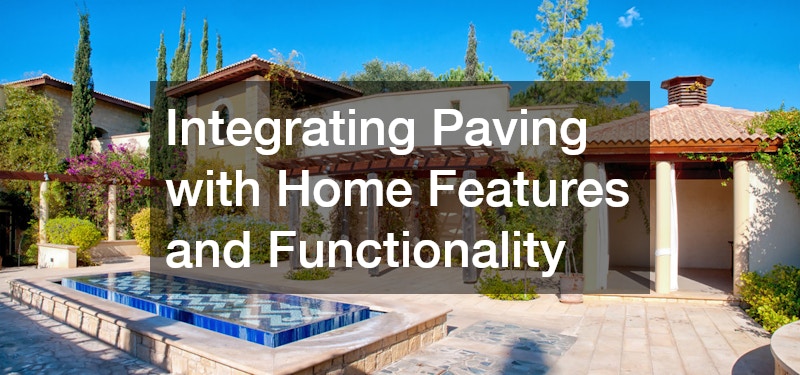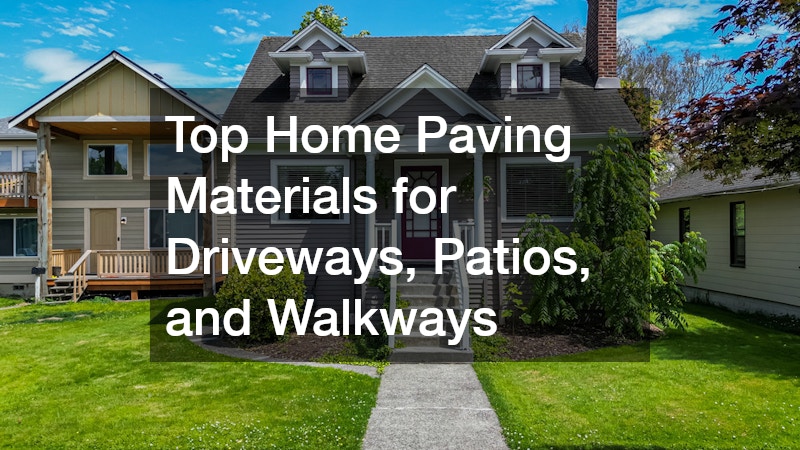A well-paved driveway, patio, or walkway does more than improve curb appeal—it enhances functionality, safety, and property value. Homeowners today have more choices than ever when selecting the right paving materials. Each option offers distinct benefits in durability, cost, aesthetics, and maintenance. Whether you’re resurfacing a driveway, designing an outdoor living space, or adding garden walkways, choosing the right materials can significantly influence both performance and appearance. The following guide explores the top home paving materials, their strengths, and their ideal applications for residential projects.
Concrete: A Versatile and Durable Classic
Concrete remains one of the most popular paving materials for driveways, patios, and walkways due to its longevity and adaptability. Known for its structural strength, concrete can withstand heavy traffic, temperature fluctuations, and moisture exposure. It’s easy to pour into customized shapes, making it suitable for both traditional and modern landscape designs.
One of the greatest advantages of concrete is its affordability compared to other paving materials. It provides a clean, sleek surface that can be finished in numerous ways, from smooth and polished to textured or colored. Stamped concrete, for example, can mimic the look of stone or brick without the high cost of those materials. Decorative concrete finishes also resist fading, cracking, and erosion when properly sealed.
When working with concrete, homeowners often consult concrete recyclers to find environmentally friendly sources of aggregate. Recycled concrete helps reduce landfill waste while lowering project costs. In addition, local recycling facilities often crush old slabs into reusable materials suitable for new construction. This makes concrete not only versatile but also sustainable.
Routine maintenance is straightforward—power washing, sealing, and occasional crack repairs are generally sufficient. Because concrete lasts for decades with proper care, it continues to rank among the most cost-effective paving materials on the market. Its adaptability, combined with eco-friendly recycling options, makes it a smart choice for modern homeowners focused on durability and sustainability.

Asphalt: Affordable Strength and Reliability
Asphalt is another widely used paving option, appreciated for its resilience and smooth finish. It’s a petroleum-based mixture of aggregate, binder, and filler that forms a flexible surface ideal for driveways and larger paved areas. Asphalt’s dark color provides a clean, uniform look that contrasts beautifully with surrounding landscaping and architecture.
For homeowners seeking a fast installation process and a long-lasting surface, asphalt stands out among paving materials. It cures quickly, allowing for use within a few days after laying. Asphalt also offers natural weather resistance, adapting well to both freezing temperatures and high heat. Unlike rigid surfaces, it expands and contracts without major cracking, making it ideal for regions with shifting seasonal conditions.
When choosing asphalt, it’s best to work asphalt companies experienced in residential projects. They ensure proper grading, drainage, and compaction—essential steps for preventing water pooling or premature wear. Over time, minor cracks and depressions may appear, but these can be easily fixed through professional asphalt repair services. Regular maintenance extends the pavement’s lifespan to 20 years or more.
One of the reasons asphalt continues to be a favorite among homeowners is its cost efficiency. It’s generally less expensive than concrete while still providing a high level of durability and a smooth driving experience. Modern formulations can also include recycled materials, reducing environmental impact. As one of the most dependable paving materials available, asphalt provides long-term functionality with minimal maintenance requirements.
Brick Pavers: Timeless Beauty with Structural Integrity
Brick pavers add classic charm and sophistication to patios, driveways, and walkways. Made from natural clay and kiln-fired for hardness, bricks have been used for centuries in paving applications due to their durability and aesthetic appeal. They come in various colors, including red, brown, and charcoal tones, allowing for creative design flexibility.
One of the key benefits of brick is its ability to withstand heavy loads without cracking. Properly laid brick pavers create interlocking patterns that evenly distribute pressure, preventing damage and ensuring long-term stability. Their modular design also makes repairs straightforward—individual bricks can be replaced without disturbing the rest of the surface.
Brick ranks high among paving materials for its timeless appearance. Whether arranged in herringbone, basket weave, or running bond patterns, bricks lend an air of sophistication to any home exterior. They also maintain their color well over time, as the pigment runs through the entire material rather than being applied only on the surface.
For those who prioritize sustainability, brick is a natural, recyclable material. Many manufacturers produce reclaimed brick pavers, preserving resources and reducing emissions associated with new production. Regular sweeping, occasional power washing, and re-sanding joints every few years will keep the surface in excellent condition. With proper care, brick pavers can last a lifetime, offering unmatched durability and elegance among paving materials.

Natural Stone: A Premium Option for Lasting Elegance
Natural stone provides a luxurious, organic appearance that enhances both modern and rustic home designs. From limestone and granite to flagstone and slate, stone is prized for its distinctive textures and unique color variations. Each piece of stone adds character, making no two surfaces exactly alike.
While natural stone tends to be more expensive than other paving materials, it offers exceptional durability and weather resistance. Its non-slip surface makes it ideal for outdoor use, especially around pools, patios, and walkways. Because of its density and strength, it can endure decades of exposure to sun, rain, and freeze-thaw cycles without losing its integrity.
When homeowners invest in stone, they often collaborate with concrete resurfacing companies to ensure seamless transitions between different surface types. This approach allows the integration of stone pavers with concrete bases for added stability and easier installation. The result is a cohesive surface that blends texture and functionality.
Stone requires minimal maintenance beyond sealing and cleaning. Sealing protects it from staining and moisture absorption, while routine sweeping helps preserve its natural luster. For those seeking one-of-a-kind beauty and long-term value, natural stone remains one of the most desirable paving materials. Its visual appeal, coupled with low upkeep, makes it a premium choice for discerning homeowners who prioritize elegance and longevity.
Concrete Finishes: Modern Customization and Performance
Traditional gray concrete has evolved into a design material with endless customization options. Homeowners can now choose finishes that mimic stone, tile, or wood while maintaining the structural advantages of concrete. Textured surfaces such as stamped or exposed aggregate concrete offer slip resistance and visual variety.
A particularly popular style is brushed concrete, which features a lightly textured surface created by dragging a broom across freshly poured material. This technique enhances traction, making it a practical choice for driveways, patios, and pool decks. The subtle lines also lend a modern, understated look that complements contemporary architecture.
When considering upgrades or repairs, homeowners often consult a local concrete contractor who can tailor finishes to match the home’s design theme. Options like colored stains, sealers, and integral pigments add depth and dimension to outdoor surfaces. Combining these finishes with durable paving materials provides both visual appeal and structural integrity.
Modern technology also allows for reinforced and fiber-enhanced mixes that increase concrete’s strength and crack resistance. With the right finish, concrete can transform from a utilitarian surface into a design statement. Among paving materials, it offers one of the best balances between beauty, cost, and performance—making it a reliable foundation for any outdoor improvement project.

Pavers and Modular Systems: Flexibility in Design
Interlocking pavers have become a favorite among homeowners seeking both creativity and practicality. Available in materials such as concrete, clay, and stone, these modular systems provide flexibility in design and ease of maintenance. Because each paver is installed individually, they can shift slightly without cracking, allowing them to adapt to soil movement and temperature changes.
Among paving materials, modular pavers excel in providing both style and strength. Their versatility makes them suitable for patios, walkways, and driveways of all sizes. Designs can range from geometric modern layouts to naturalistic patterns that mimic cobblestone streets. Many homeowners choose them to create outdoor living areas that blend seamlessly with landscaping features.
For patio designs, a patio paver can serve as the foundation for functional outdoor spaces, from dining areas to garden paths. Available in an array of shapes and textures, these pavers enable homeowners to personalize their landscapes without extensive construction. They are easy to clean, simple to replace, and resistant to most weather-related wear.
Maintenance is relatively low compared to poured materials. Occasional sweeping, re-sanding joints, and sealing can keep them looking fresh for years. In terms of sustainability, many paver systems are permeable, allowing water to drain naturally into the ground, which reduces runoff and supports eco-friendly landscaping. For homeowners seeking customizable, resilient, and visually striking paving materials, modular pavers are an ideal choice.
Asphalt and Concrete Maintenance: Extending Surface Life
Over time, even the strongest paving materials require upkeep. Weather exposure, heavy traffic, and seasonal temperature changes can cause minor surface deterioration. Fortunately, regular maintenance can dramatically extend the life of asphalt and concrete installations, preserving both function and appearance.
For asphalt surfaces, timely crack sealing, patching, and sealcoating prevent water infiltration and structural weakening. Asphalt services typically include comprehensive care plans to maintain smoothness and durability. Working with professionals ensures that the right materials and techniques are used for long-lasting results. Periodic attention helps reduce the need for costly replacements later on.
Concrete surfaces, including driveways and patios, benefit from cleaning, resealing, and repairs as needed. If an older concrete driveway begins to show signs of wear, resurfacing is often a cost-effective solution. Instead of replacing the entire slab, contractors can apply a thin overlay to restore appearance and performance. Many homeowners rely on specialized teams that focus exclusively on resurfacing for efficient, high-quality results.
Proper drainage and expansion joints are also key to prolonging the life of paved areas. When done correctly, maintenance not only preserves the structural integrity of paving materials but also enhances curb appeal. Whether you’re caring for asphalt or concrete, consistent attention is the best way to maximize value and longevity in your outdoor surfaces.

Integrating Paving with Home Features and Functionality
A cohesive outdoor design extends beyond choosing the right paving materials—it involves harmonizing them with other structural and aesthetic elements of your property. For instance, pairing a new driveway with an updated garage door can create a balanced and polished exterior. Many homeowners consult a local garage door installer when planning major upgrades to ensure that finishes and materials complement one another.
Driveways and walkways should enhance accessibility and direct flow through the property, while patios should encourage relaxation and social gatherings. Using different textures or colors to define these zones adds visual depth and practicality. For example, combining smooth concrete with textured pavers can create a subtle contrast and reduce slipping hazards in high-traffic areas.
Drainage is another critical aspect of integration. Proper grading ensures that water flows away from foundations, preventing erosion and damage. Homeowners often collaborate with local concrete contractor teams to ensure that slope, joint placement, and sealing align with environmental conditions. These professionals also help identify the best paving materials for durability and weather performance based on local climate factors.
Incorporating lighting, landscaping, and edging further elevates the overall aesthetic. Solar pathway lights, border stones, and garden beds soften the look of hard surfaces, making them inviting and cohesive with surrounding greenery. By viewing paving as part of an integrated design rather than a standalone feature, homeowners can achieve a seamless blend of functionality and style across their outdoor spaces.
Sustainability and Innovation in Paving Design
As environmental awareness grows, the demand for sustainable paving materials continues to rise. Homeowners and builders are increasingly turning to options that minimize carbon footprints and maximize recyclability. Many modern solutions combine strength with eco-conscious engineering, helping households reduce their environmental impact while maintaining aesthetic quality.
One of the most effective sustainable strategies is to partner with concrete recyclers. They reclaim materials from demolished structures, crush them, and repurpose the aggregate for new installations. This practice significantly reduces waste and reliance on virgin raw materials. It also lowers transportation emissions when homeowners source locally. Permeable paving systems are gaining popularity. These allow rainwater to pass through the surface, replenishing groundwater and reducing runoff that contributes to erosion and flooding. When used in conjunction with durable paving materials, permeable systems balance sustainability with performance.
Asphalt production has also evolved, incorporating recycled content and energy-efficient manufacturing methods. Similarly, innovative sealants and coatings reduce maintenance needs while extending surface life. For homeowners, sustainability doesn’t mean sacrificing design or durability—it means making smarter choices that benefit both property and planet.
By investing in eco-friendly materials and modern paving practices, today’s homeowners can enjoy long-lasting, visually appealing surfaces that align with environmental values. The evolution of paving technology ensures that sustainability and innovation will continue to shape how driveways, patios, and walkways are designed in the years to come.
Selecting the right paving materials for driveways, patios, and walkways is both a practical and aesthetic decision. Each option—from concrete and asphalt to brick, stone, and modular pavers—offers unique advantages in strength, appearance, and cost. By understanding the distinct properties of each material, homeowners can create outdoor spaces that are durable, sustainable, and visually cohesive.
Working with professionals such as local concrete contractor teams or asphalt companies ensures that installations are completed to high standards. Incorporating design elements like brushed concrete finishes or custom patio pavers can further personalize your outdoor areas.
